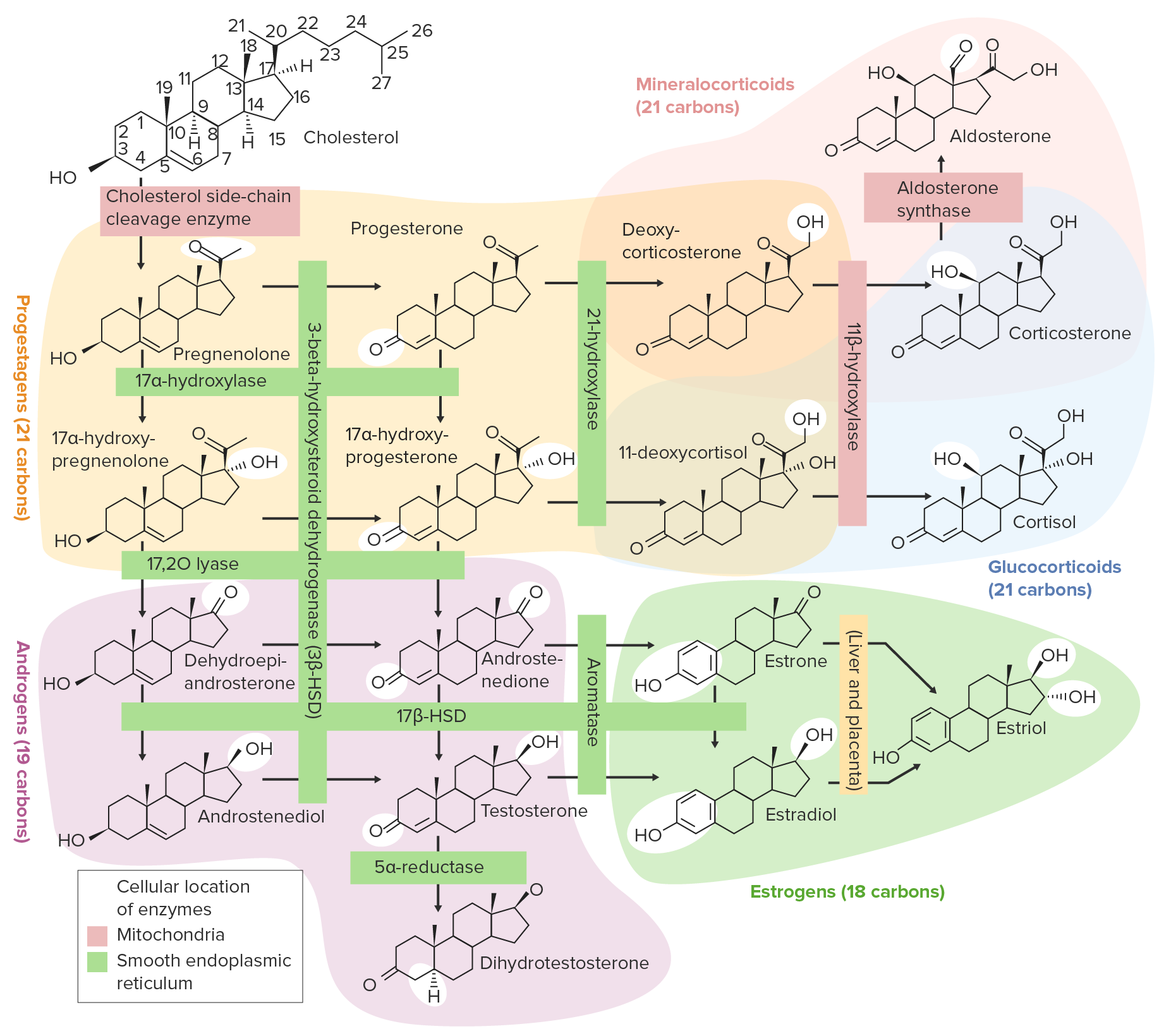Playlist
Show Playlist
Hide Playlist
Testosterone Effects
-
Slides Male Hormones Endocrine System.pdf
-
Download Lecture Overview
00:00 How do you transport testosterone in the blood? Because remember testosterone is a steroid hormone, meaning that it is lipophilic. Therefore you need to bind something to it to carry it around. Sex hormone-binding globulin binds about 44 or so percent of the testosterone. 00:21 The rest of it is bound with two other items, either albumin or corticosteroid-binding globulin. 00:27 Interesting here that a glucocorticoid such as cortisol can use the same binding globulin as testosterone. That leaves about 2% free and it's only the free testosterone that's going to have biological action. Testosterone has its biological action by binding to a nuclear receptor. 00:51 Now what does it do in the peripheral tissue? Well part of it gets converted. So testosterone gets converted to DHT, which is more potent. It also is converted sometimes to 17-ketosteroids. So there is some peripheral conversion that could take place of the testosterone that's circulating around then the rest of it, however, binds to nuclear receptors to undergo protein transcription and translation. Whatever is circulating around though will eventually be metabolized by the kidney and exited out by the urine. These nuclear receptors for both testosterone and DHT bind to these androgen receptors and translocate into the nucleus so that this process involves making new proteins. Thus, testosterone responses and DHT responses will be a bit slower than some of the other hormones. It takes time to make a new protein to bind to DNA, go to transcription and translation. So what are these effects of testosterone? Well first, there is a large effect on both bone growth and connective tissue growth. Muscle growth is very important and part of testosterone's effect. There are also effects on the reproductive organs. Secondary sex characteristics will be engaged such as growth of the voice box or larynx as well as spermatogenesis. Facial hair, axillary, pubic hair growth is part of testosterone's effect. Testosterone also though affects reproductive organ such as the testes, the prostate, the seminal vesicles as well as the penis. The skin is also affected by testosterone and this involves increase in sebaceous gland secretions. So sebaceous glands are interesting in that they are not really affected by the nervous system, rather it is androgens that upregulate sebaceous gland secretions. Therefore, in times of high testosterone there will be a lot of oil along the skin because that process is being upregulated at that point. Testosterone involves anabolic effects of bone and muscle. Therefore, we are talking about increasing in bone growth, connective tissue as well as muscle growth. What regulates testosterone? Testosterone involves again this three-tiered process of having hypothalamic, gonadotropin-releasing hormone, anterior pituitary gonadotropes, LH, FSH and the testes. The testes are going to produce two substances, one is inhibin and the other is testosterone. Both inhibin and testosterone act as negative feedback to either the anterior pituitary or to both the anterior pituitary and the hypothalamus. So it is testosterone that negatively feedbacks on the gonadotropes as well as the hypothalamic nuclei to decrease this production. Over the course of the lifetime, there is a lot of change in testosterone. If you think about the development process, upon birth there is a little bit of testosterone release but then it is very quiet until about the onset of puberty. At that point, there is a large increase in the testosterone until one becomes an adult. It helves off pretty constant for most of adulthood and then at old age it starts to decrease a little bit.
About the Lecture
The lecture Testosterone Effects by Thad Wilson, PhD is from the course Reproductive Physiology.
Included Quiz Questions
The anabolic effects of testosterone involve the growth of which of the following?
- Connective tissue
- Sweat glands
- Peripheral nerves
- Blood vessels
What percentage of testosterone is bound to sex-hormone-binding globulin?
- 44%
- 40%
- 50%
- 55%
- 60%
What is the difference between testosterone and DHT?
- DHT is more potent than testosterone.
- There is more DHT in the blood.
- Testosterone is derived from DHT.
- Testosterone is more potent than DHT.
- DHT is the precursor of testosterone.
Which of the following is a secondary sex characteristic developed under the influence of testosterone?
- Growth of pubic hair
- Growth of testes
- Growth of the penis
- Growth of prostate
- Growth of seminal vesicles
Customer reviews
5,0 of 5 stars
| 5 Stars |
|
5 |
| 4 Stars |
|
0 |
| 3 Stars |
|
0 |
| 2 Stars |
|
0 |
| 1 Star |
|
0 |






